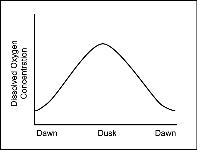

 |
||||||||||||
 |
||||||||||||
| Dissolved Oxygen for Fish Production 1 | ||||||
| Ruth Francis-Floyd | March 15, 2002 | |||||
What Is Dissolved Oxygen? Dissolved oxygen (DO) refers to oxygen gas that is dissolved in water. Fish "breathe" oxygen just as land animals do. However, fish are able to absorb oxygen directly from the water into their bloodstream using gills, whereas land animals use lungs to absorb oxygen from the atmosphere. What are the Sources of Oxygen in an Aquatic Environment? There are three main sources of oxygen in the aquatic environment: 1) direct diffusion from the atmosphere; 2) wind and wave action; and 3) photosynthesis. Of these, photosynthesis by aquatic plants and phytoplankton is the most important. Oxygen, derived from photosynthesis, is produced during the day when sunlight shines on the plants in the water. Oxygen levels drop at night because of respiration by plants and animals, including fish. These predictable changes in DO that occur every 24 hours are called the diurnal oxygen cycle ( Figure 1 ). 
Figure 1: Dissolved oxygen concentration in ponds fluctuates on a 24-hour basis. This fluctuation is called a diurnal oxygen cycle. Dissolved oxygen increases during daylight hours when photosynthesis is occurring and decreases at night when respiration continues but photosynthesis does not. What is Oxygen Depletion? Oxygen depletion refers to low levels of DO and may result in fish mortality. A concentration of 5 mg/L DO is recommended for optimum fish health. Sensitivity to low levels of dissolved oxygen is species specific, however, most species of fish are distressed when DO falls to 2-4 mg/L. Mortality usually occurs at concentrations less than 2 mg/L. The number of fish that die during an oxygen depletion event is determined by how low the DO gets and how long it stays down. Usually larger fish are affected by low DO before smaller fish are. What Causes Oxygen Depletion? Oxygen depletion occurs when oxygen consumption exceeds oxygen production. Increases in oxygen consumption can be caused by an over-abundance of aquatic plants or algae in the ecosystem, "turnover" of a body of water (see Stratification/Pond Turnover section), increased organic waste entering the water (i.e., manure from feedlots, septic tank waste water, and excess fish feed), death and decay of organic matter (i.e., plant or algae die-offs), or by certain chemicals (i.e., formalin) that remove oxygen directly from the water column. Why Are Oxygen Depletion Events Most Troublesome in the Summer? In outdoor ponds, oxygen depletion events can occur at anytime, however, they are most likely to cause fish kills during hot summer weather. A decrease in oxygen production is caused by incidents such as cloudy weather and plant or algae die-offs that shut down photosynthesis. Heavy populations of plants or algae are the most important producers of oxygen in the system. However, they are also the most important users of oxygen. There are several reasons why oxygen depletion events are more common in the summer and they are discussed below. more ... |
 |
|||||
| About Us :: Message Board :: Chat | |||||
| Library :: Photo Gallery :: Links & Resources :: Breeders & Sponsors :: Merchandise | |||||
| Website designed by: EthanCote.com | © 2001-2004, SimplyDiscus.com. All Rights Reserved. | ||||